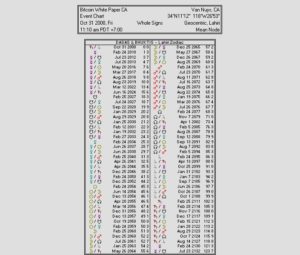Caution: The following material is for informational purposes only, and is not intended to provide, and should not be relied on for, financial advice. You should consult your own financial advisors before engaging.
This article was co-written by me (Juliana Swanson) and by Dr. Sisira Amarasinghe, my former student and a dear friend and colleague. Sisira is an Information Systems Engineering specialist with extensive academic and industrial experience in a range of domains covering Enterprise IT, Biomedical, Automotive, and Industrial Automation. He became interested in Vedic astrology a couple of decades ago and initially pursued his Vedic astrology studies with me prior to progressing into further studies. Sisira may be reached by email at: Sisira.Amarasinghe@VedicAstrology.PRO
Preface
This article builds on the foundation and the theme introduced and formulated in the three previous parts (One, Two, and Three) in the same series. While this article is intended to be self-contained, it is best reviewed in combination with the others. (Please note that all astrological information shared on this blog is based on Vedic astrology and the sidereal “nirayana” zodiac, not the tropical “ayana” system in use by most western and a few Vedic astrologers).
Key Planetary Indicators in the Bitcoin Chart
We analyzed the astrological patterns correlated with Bitcoin price fluctuations and found a set of distinct patterns based on the planetary transits as well as the Vimshottari dasha, a progressed Vedic astrology planetary system for tracking life cycles. As discussed in previous articles, our rectified Sagittarius-Mula ascendant horoscope for Bitcoin has a Kala Sarpa Yoga in which all the planets occupy one side of the chart hemmed between the lunar nodes (Rahu and Ketu). Since the lunar nodes are responsible for eclipses, their transits (which create eclipses) were found to be highly significant in tracking highs and lows, and especially lows. More specifically, our research shows that eclipses involving Saturn and the North or South Nodes (Rahu and Ketu) in aspect to the natal or transiting Sun, Mars, or Mercury have in the past pointed to a dip or low period in Bitcoin’s price.
 Additionally, Saturn’s transit near the Ascendant and/or Pluto and the Sun and Mars has generally proved to be a trigger for declines, as well. This is because Saturn’s nature is to limit or delay, and Saturn is also Avayogi, a planet which can further indicate impediments to wealth according to the Iyer prosperity point system in Nadi Jyotisha. Pluto is a planetary giver of wealth, and Mars is ruler of the fifth house of fortune and speculative gains. According to the Iyer prosperity points, the the Sun is the Yogi, the main significator of prosperity; and Mercury is Duplicate Yogi, a secondary wealth indicator which augments the prosperity promised by the Duplicate Yogi.
Additionally, Saturn’s transit near the Ascendant and/or Pluto and the Sun and Mars has generally proved to be a trigger for declines, as well. This is because Saturn’s nature is to limit or delay, and Saturn is also Avayogi, a planet which can further indicate impediments to wealth according to the Iyer prosperity point system in Nadi Jyotisha. Pluto is a planetary giver of wealth, and Mars is ruler of the fifth house of fortune and speculative gains. According to the Iyer prosperity points, the the Sun is the Yogi, the main significator of prosperity; and Mercury is Duplicate Yogi, a secondary wealth indicator which augments the prosperity promised by the Duplicate Yogi.
 Venus and Jupiter are supplementary prosperity indicators in the Bitcoin horoscope. Some of the previous prosperous transits for Bitcoin involved Mars, the Sun, Mercury, Venus, and Jupiter. When transiting unafflicted and supporting each other in the first, second, fourth, fifth, eighth, tenth, and eleventh houses of the main rashi chart and/or the Sripati Bhava chart, there have been some significant highs in Bitcoin’s value.
Venus and Jupiter are supplementary prosperity indicators in the Bitcoin horoscope. Some of the previous prosperous transits for Bitcoin involved Mars, the Sun, Mercury, Venus, and Jupiter. When transiting unafflicted and supporting each other in the first, second, fourth, fifth, eighth, tenth, and eleventh houses of the main rashi chart and/or the Sripati Bhava chart, there have been some significant highs in Bitcoin’s value.
 Astrological Interpretation of Core Characteristics and Volatility of Bitcoin
Astrological Interpretation of Core Characteristics and Volatility of Bitcoin
 Astrology can explain and confirm the extreme high for Bitcoin from November 12, 2017 until December 18, 2017 in which the value spiked 230.24% from $5,857.32 to $19,343.04. This was followed by a significant decline from December 16, 2017 until February 5, 2018, from $19,343.04 to $6,914.26, a drop of 64.25%. After this, Bitcoin has remained relatively flat.
Astrology can explain and confirm the extreme high for Bitcoin from November 12, 2017 until December 18, 2017 in which the value spiked 230.24% from $5,857.32 to $19,343.04. This was followed by a significant decline from December 16, 2017 until February 5, 2018, from $19,343.04 to $6,914.26, a drop of 64.25%. After this, Bitcoin has remained relatively flat.
 The eclipses nearest to this period from November 2017 into February 2018 are a key to understanding what happened. The super blue Moon total lunar eclipse of January 31, 2018 is very important. The effects of lunar eclipses like this can resonate forward and backward about a month for every hour of the total eclipse. In this case, the total lunar eclipse duration was 1 hour and 43 minutes so it had an effect going backward and forward into late December and early February.
The eclipses nearest to this period from November 2017 into February 2018 are a key to understanding what happened. The super blue Moon total lunar eclipse of January 31, 2018 is very important. The effects of lunar eclipses like this can resonate forward and backward about a month for every hour of the total eclipse. In this case, the total lunar eclipse duration was 1 hour and 43 minutes so it had an effect going backward and forward into late December and early February.
 The reason that the January 31 lunar eclipse and the partial solar eclipse that followed in February 15, 2018 were so significant is that they occurred during a transit to the rectified Bitcoin chart known as the Converse (or Inverse) Nodal Return, in which the transiting North Node (Rahu) was crossing over or near the degree of the natal South Node (Ketu), and vice versa. The exact Converse Nodal Return culminated on February 17, 2018, but was in orb (effective) for several months either side of that date. This nodal transit happens every 18.5 years and usually represents a period of confusion, karmic struggle, changes in plans, new directions, and extreme highs, lows, and turnarounds.
The reason that the January 31 lunar eclipse and the partial solar eclipse that followed in February 15, 2018 were so significant is that they occurred during a transit to the rectified Bitcoin chart known as the Converse (or Inverse) Nodal Return, in which the transiting North Node (Rahu) was crossing over or near the degree of the natal South Node (Ketu), and vice versa. The exact Converse Nodal Return culminated on February 17, 2018, but was in orb (effective) for several months either side of that date. This nodal transit happens every 18.5 years and usually represents a period of confusion, karmic struggle, changes in plans, new directions, and extreme highs, lows, and turnarounds.
 Bitcoin experienced tremendous growth since August 2017, which has been in some ways pulled back. However, numerous financial institutions are beginning to accept Bitcoin as a form of payment. For example, Square has already incorporated Bitcoin as mode of payment in its merchant solution system. As such, it is anticipated that Bitcoin will gain widespread recognition by early 2019 leading to recovery of most of lost potential and gaining some more.
Bitcoin experienced tremendous growth since August 2017, which has been in some ways pulled back. However, numerous financial institutions are beginning to accept Bitcoin as a form of payment. For example, Square has already incorporated Bitcoin as mode of payment in its merchant solution system. As such, it is anticipated that Bitcoin will gain widespread recognition by early 2019 leading to recovery of most of lost potential and gaining some more.
The mean lunar nodes are transiting and eclipsing in the Capricorn/Cancer – 2/8 money axis of the Bitcoin horoscope from August 17, 2017 until March 6, 2019, which reflects a time of tremendous upheaval, growth, and transformation for Bitcoin and other cryptocurrencies. This transit promises to keep things quite interesting though somewhat unpredictable. After this on March 6, 2019, the mean lunar nodes will move to the 1/7 axis with Rahu in Gemini/seventh house, and Ketu in Sagittarius/first house, and will remain in this section of the zodiac until September 22, 2020. This may be a period when more and more institutional investors become involved with Bitcoin, and when Bitcoin is taken much more seriously by the mainstream.
Having had remarkable upward trajectory, Bitcoin remained more-or-less flat for six months or so since February 2018. This was primarily brought upon due to constraints instituted by some governments in order to mitigate cryptocurrency instability as well as to promote some regulation.
As a general rule, a solar eclipse tends to resonate backward and forward about six months. The partial solar eclipse on February 15, 2018 triggered a six-month flat cycle for Bitcoin because, when we align this eclipse chart alongside the Bitcoin birth chart (see the triwheel chart above), not only were the nodes inverted in the money axis, as described previously, but also, fifth lord Mars was transiting in a weakened position in the twelfth house of the Bitcoin chart. In addition, the Duplicate Yogi Mercury was eclipsed by the Sun and Moon (luminaries).
During the time period of July-August 2018, Bitcoin appeared to be promising a come-back only to eventually disappoint investors eventually.
With the July 27, 2018 total lunar eclipse chart aligned alongside Bitcoin’s chart, we see that the fifth lord Mars was retrograde (held back) in the second house where it was also eclipsed by Ketu which suggests a decline in growth since Ketu often has a diminishing effect. The powers of the Sun and Mercury (Yogi and Duplicate Yogi) were disrupted in the eighth house of uncertainty. The total eclipse lasted about an hour and 45 minutes, so the effects of this eclipse resonate forward and backward almost two months.This period appears to last until October considering that transiting Mars will cross the eclipse points in late September.
 Astrological Outlook for Bitcoin
Astrological Outlook for Bitcoin
Examining the August 11, 2018 partial solar eclipse relative to the Bitcoin chart, Mars is still retrograde in the second house, and the luminaries and Mercury occupy the eighth house, but they are not close to the eclipsing body of the North Node (Rahu) as the eclipse was only partial/weak, so it may be that this eclipse has a less diminishing impact on Bitcoin going forward to the next eclipses which will occur in January 2019.
In the last quarter of 2018 or early 2019 and possibly through the first months of 2019 at least, Bitcoin could see another temporary price decline or sluggish period as the partial eclipse of January 5, 2019 occurs in the first house of the Bitcoin chart with Saturn, and Ketu will conjoin the natal Part of Fortune, while Jupiter and Venus transit the twelfth house of loss and decline.
 A total solar eclipse in sidereal Gemini will occur on July 2, 2019, involving the Moon’s North Node (Rahu) with the luminaries and Venus in the seventh house of the Bitcoin chart. This area of the horoscope relates to business alliances and events affecting social and economic evolution. Gemini itself in mundane astrology represents institutional investing which is what we will see expanding “to the Moon” when Bitcoin really takes off. This eclipse may set the stage for some newfound power and expansive breakthroughs for Bitcoin and cryptocurrencies at various times in 2019 (this eclipse’s effects will resonate through much of 2019).
A total solar eclipse in sidereal Gemini will occur on July 2, 2019, involving the Moon’s North Node (Rahu) with the luminaries and Venus in the seventh house of the Bitcoin chart. This area of the horoscope relates to business alliances and events affecting social and economic evolution. Gemini itself in mundane astrology represents institutional investing which is what we will see expanding “to the Moon” when Bitcoin really takes off. This eclipse may set the stage for some newfound power and expansive breakthroughs for Bitcoin and cryptocurrencies at various times in 2019 (this eclipse’s effects will resonate through much of 2019).
 A powerful annular solar eclipse in sidereal Sagittarius will occur on December 25-26, 2019. This eclipse will involve a significant conjunction of planets eclipsed by the Moon’s South Node (Ketu) in sidereal Sagittarius, involving the transiting Sun, Moon, Mercury, Saturn, and Pluto. The eclipse will activate in the most vital first house of the Bitcoin chart, where it will also align with the natal Ascendant, Jupiter, and Pluto. Generally, solar eclipses tend to resonate for six months forward and backward. Another way of looking at it even more specifically is to calculate a month for every minute of the solar eclipse totality, which in this case will be about three and a half minutes, so it might have a have a resonance for at least three and a half months going forward and backward from the actual eclipse.
A powerful annular solar eclipse in sidereal Sagittarius will occur on December 25-26, 2019. This eclipse will involve a significant conjunction of planets eclipsed by the Moon’s South Node (Ketu) in sidereal Sagittarius, involving the transiting Sun, Moon, Mercury, Saturn, and Pluto. The eclipse will activate in the most vital first house of the Bitcoin chart, where it will also align with the natal Ascendant, Jupiter, and Pluto. Generally, solar eclipses tend to resonate for six months forward and backward. Another way of looking at it even more specifically is to calculate a month for every minute of the solar eclipse totality, which in this case will be about three and a half minutes, so it might have a have a resonance for at least three and a half months going forward and backward from the actual eclipse.
 Jupiter being eclipsed in the December 2019 solar eclipse suggests the possibility of significant expansion and momentum for Bitcoin around the period mentioned. This is even more likely as Jupiter is the ruler of the Bitcoin chart. Pluto also being eclipsed suggests some kind of rebirth or resurgence for Bitcoin during this time. The South Node (Ketu) being the eclipsing shadow implies that an old paradigm of Bitcoin or cryptocurrencies will be cleared away to make room for new growth and development, and Ketu is the planet of re-organization so that would be part of this process.
Jupiter being eclipsed in the December 2019 solar eclipse suggests the possibility of significant expansion and momentum for Bitcoin around the period mentioned. This is even more likely as Jupiter is the ruler of the Bitcoin chart. Pluto also being eclipsed suggests some kind of rebirth or resurgence for Bitcoin during this time. The South Node (Ketu) being the eclipsing shadow implies that an old paradigm of Bitcoin or cryptocurrencies will be cleared away to make room for new growth and development, and Ketu is the planet of re-organization so that would be part of this process.
This mirrors another important event known as the Jupiter Return, which will happen on February 16, 2020. Approximately every 12 years, Jupiter, planet of fortune and purpose, will have traveled all the way around the zodiac to meet up with natal Jupiter at the point where it is in the birth chart of a person or entity, and this is considered to be a time of fresh new inspiration, bountiful good luck, and the strong possibility of a major rebirth as new ideas and opportunities are unveiled.

 The influence of transiting Jupiter is important to track because it’s lord of the Bitcoin chart, lord of the fourth house of assets, and is also the natural planet of dharma (that which upholds the path and purpose). Jupiter has been transiting in sidereal Libra in the eleventh house of gains since September 2017, and this transit will be in place until October 11, 2018. This is a strong house for the Bitcoin chart, but Jupiter was retrograde from March 9 to July 11 during a period when Bitcoin’s price was flat. The retrograde motion can sometimes hold back some of its natural abundance. Jupiter moved out of retrograde (went direct) in July 2018, but with the Saturn retrograde transit in the first house of Sagittarius and near the Ascendant, along with the 2018 eclipses, the price of Bitcoin has been restrained.
The influence of transiting Jupiter is important to track because it’s lord of the Bitcoin chart, lord of the fourth house of assets, and is also the natural planet of dharma (that which upholds the path and purpose). Jupiter has been transiting in sidereal Libra in the eleventh house of gains since September 2017, and this transit will be in place until October 11, 2018. This is a strong house for the Bitcoin chart, but Jupiter was retrograde from March 9 to July 11 during a period when Bitcoin’s price was flat. The retrograde motion can sometimes hold back some of its natural abundance. Jupiter moved out of retrograde (went direct) in July 2018, but with the Saturn retrograde transit in the first house of Sagittarius and near the Ascendant, along with the 2018 eclipses, the price of Bitcoin has been restrained.
Jupiter will transit in sidereal Scorpio in the twelfth house from October 11, 2018 until November 4, 2019. Jupiter does not have a strong Bhinnashtakavarga score in Scorpio (only 2 out of 8 bindus), so it appears that much of the action in Bitcoin during this cycle will take place behind the scenes, and also in crypto-philanthropy and international development (twelfth house themes). Jupiter will actually dip in and out of Sagittarius and the first house from March 29 until April 22, 2019. After that, it will transit into sidereal Sagittarius from November 4, 2019 until November 20, 2020, dipping into Capricorn for a short period in the spring of 2019. Jupiter has a very high Bhinnashtakavarga score in Sagittarius (7 bindus out of 8), so the Jupiter transit in Sagittarius may have a very positive impact on Bitcoin’s development, price, and adoption.
 As mentioned, Saturn is the Avayogi which can represent impediments to the wealth of Bitcoin. Saturn is also the second lord of the Bitcoin chart which signifies the financial growth potential of Bitcoin. When Saturn transits retrograde, it is more encumbering than when it is transiting in direct motion. In 2018, Saturn’s retrograde cycle spanned from April 17 until September 6. Saturn was also transiting relatively near to the natal Ascendant and natal Pluto in the Bitcoin chart, which suggests a slowing down or flattening effect. Based on this, I believe that Bitcoin may possibly rally in the last quarter of 2018 because Saturn will no longer be retrograde after September 6, and as it goes direct it will be moving further away from the natal Ascendant where it has been impeding Bitcoin and other cryptocurrencies.
As mentioned, Saturn is the Avayogi which can represent impediments to the wealth of Bitcoin. Saturn is also the second lord of the Bitcoin chart which signifies the financial growth potential of Bitcoin. When Saturn transits retrograde, it is more encumbering than when it is transiting in direct motion. In 2018, Saturn’s retrograde cycle spanned from April 17 until September 6. Saturn was also transiting relatively near to the natal Ascendant and natal Pluto in the Bitcoin chart, which suggests a slowing down or flattening effect. Based on this, I believe that Bitcoin may possibly rally in the last quarter of 2018 because Saturn will no longer be retrograde after September 6, and as it goes direct it will be moving further away from the natal Ascendant where it has been impeding Bitcoin and other cryptocurrencies.
According to Sarvashtakavarga (SAV), the second house/Capricorn in the Bitcoin chart is very strong (30 points), whereas the first house/Sagittarius is average (25 points). According to this system, a house with a strong SAV score will manifest the most auspicious results when planets are transiting there. Accordingly, it appears that when Saturn transits in sidereal Capricorn (January 17, 2020 to January 23, 2023), the value of and support for Bitcoin could grow tremendously, especially during the times that Jupiter is transiting there concurrently in 2020-2021.

 This also coincides with the next Great Mutation cycle in which Jupiter and Saturn will conjoin in sidereal Capricorn in 2020-2021. They will be exactly conjunct December 21, 2020, but both will be together in Capricorn on and off through most of 2020 and 2021. They come together in conjunction in a new sign approximately every 20 years, marking an important developmental cycle which was known to ancient astrologers as the “Great Chronocrator.” Jupiter is the planet of dharma and Saturn of karma, and when they come together, they represent a new cycle of socio-economic and cultural development.
This also coincides with the next Great Mutation cycle in which Jupiter and Saturn will conjoin in sidereal Capricorn in 2020-2021. They will be exactly conjunct December 21, 2020, but both will be together in Capricorn on and off through most of 2020 and 2021. They come together in conjunction in a new sign approximately every 20 years, marking an important developmental cycle which was known to ancient astrologers as the “Great Chronocrator.” Jupiter is the planet of dharma and Saturn of karma, and when they come together, they represent a new cycle of socio-economic and cultural development.
Saturn and Jupiter will conjoin in Capricorn in the second house of financial wealth, banking, and collective values, not only in the rectified Bitcoin chart but also in the U.S. (Kelleher) birth chart, as both have Sagittarius Ascendant. This conjunction will set the stage for the next 20-year transformation of established power structures, including those overseen by the ruling elite (Capricorn). All kinds of outmoded systems will be eradicated and replaced by newer more innovative commercial, financial, and technological advances.
It seems highly likely that the expansion of Bitcoin, the blockchain, and other cryptocurrencies will be a result of the Great Chronocrator’s next awakening, especially as the exact conjunction activates the Part of Fortune in the Bitcoin chart. (It’s of special note that the Saturn-Jupiter exact conjunction will also conjoin natal Pluto in the U.S. Kelleher chart, possibly indicative of a remarkable economic upheaval and transformation).

 According to Vedic astrology’s progressed Vimshottari dasha system, calculated from the Moon, the Bitcoin chart has been in the seventeen-year Mercury maha-dasha (great cycle) since February 2010, and this will extend until February 2027. As mentioned in the previous Bitcoin article, Mercury is the exalted ruler of the tenth house in the 29th degree of the sign, which symbolizes the evolutionary gift that Bitcoin has for humanity. Mercury is also conjunct the fixed star Arcturus which brings great financial profits through large-scale endeavors. Mercury additionally conjoins the fixed star Spica which reveals unbounded and unprecedented good fortune.
According to Vedic astrology’s progressed Vimshottari dasha system, calculated from the Moon, the Bitcoin chart has been in the seventeen-year Mercury maha-dasha (great cycle) since February 2010, and this will extend until February 2027. As mentioned in the previous Bitcoin article, Mercury is the exalted ruler of the tenth house in the 29th degree of the sign, which symbolizes the evolutionary gift that Bitcoin has for humanity. Mercury is also conjunct the fixed star Arcturus which brings great financial profits through large-scale endeavors. Mercury additionally conjoins the fixed star Spica which reveals unbounded and unprecedented good fortune.
Nonetheless, with Mercury at the edgy 29th degree (sandhi/end of the sign), we see a dynamic similar in effect to the Bitcoin chart’s intensely fated, erratic, and metamorphic Kala Sarpa Yoga. This makes sense as Bitcoin by its very nature is highly disruptive and operating in uncharted territory, and the volatile effects of this are especially pronounced during the Mercury maha-dasha.
 Within the maha-dashas, there are also minor periods going down to five levels. The second level is most important. The one currently in place from August 26, 2018 until August 23, 2019 is the Mars bhukti (or antardasha). This might be very good for Bitcoin overall as Mercury and Mars combine forces to form a Raja Yoga variation created when an angular lord of action and power joins exponential forces with a trinal lord of opportunity and fortune. In this case, Mercury rules two angles (the first and tenth houses), and Mars rules a trine (the fifth house). Raja Yoga is a success-making combination.
Within the maha-dashas, there are also minor periods going down to five levels. The second level is most important. The one currently in place from August 26, 2018 until August 23, 2019 is the Mars bhukti (or antardasha). This might be very good for Bitcoin overall as Mercury and Mars combine forces to form a Raja Yoga variation created when an angular lord of action and power joins exponential forces with a trinal lord of opportunity and fortune. In this case, Mercury rules two angles (the first and tenth houses), and Mars rules a trine (the fifth house). Raja Yoga is a success-making combination.
After the Mercury maha-dasha ends in 2027, the seven-year Ketu cycle will be in place until 2034, and may prove to be a period of significant reorganization and restructuring for Bitcoin. Following the Ketu period, the twenty-year Venus mahadasha from 2034-2054 should be mostly “smooth sailing.” The 6-year Sun maha-dasha will begin after the Venus maha-dasha ends, when Bitcoin is 45+ years old in 2054, and it will extend until 2060. It is possible that Bitcoin will have its demise during the Sun cycle, or at least it will morph into something else then. This is because the Sun, the soul of Bitcoin, is debilitated (weak), aspected by Saturn (death), and in the eleventh house, which according to some tenets of Vedic astrology is known as “hara,” meaning “destroyer.”
Conclusion
Building on the fundamentals and core characteristics of Bitcoin and its rectified horoscope as detailed in the first three articles in this series, this current article provides further analysis of some of Bitcoin’s attributes reflected in a variety of key astrological indicators. The section on astrological interpretation and important features addresses specifics of Bitcoin’s behavior with respect to a number of key planetary transits which include eclipses.
The segment on the astrological outlook for Bitcoin analyzes a number of significant periods of Bitcoin’s performance into the future and also explains why Bitcoin’s growth has been sluggish in the recent past. The article also provides a concluding time era for Bitcoin at which point it may see its demise or transform into something else. It is anticipated that the initial research work and analysis presented in this series of articles will provide a basis for further analysis and research along similar topics related to Bitcoin and other cryptocurrencies.

